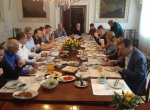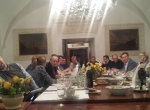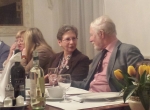Third meeting in Nieborów, 17-19.2016
The third meeting of the team implementing the Migration Period between Odra and Vistula Project was held at Nieborów on 17-19 April. Present at this encounter were also guests from eight countries, and four members of the Project Steering Committee: thirty participants in all. Among the guests from outside Poland were outstanding researchers of Late Antiquity and the Migration Period, eg, prof. Peter Heather (Great Britain), dr. Michel Kazansky (France), prof. Mikhail Lubichev (Ukraine), dr. Maria Panum Baastrup (Denmark), dr. Karol Pieta (Slovakia), dr. Peter Prohaszka (Hungary), dr. Andreas Rau (Germany), prof. Michael Schmauder (Germany); an eminent guest from the University of Warsaw was prof. Adam Ziółkowski (University of Warsaw).
In total, 21 papers were presented, interdisciplinary in character, addressing both the issues of terminology, theory, methodology and chronology; history and palaeobotany, as well as strictly archaeological matters (see program). Some recently found, spectacular materials were presented, challenging to the previously accepted models of settlement change between the Odra and the Vistula around the middle of the first millennium AD, and more particularly, undermining the views on the lingering of Germanic settlement in central and northern Poland, and also on influences from various cultural centres of Europe of the day. Some vital conclusions were formulated after the discussion and, basing on the advice given by the members of the Steering Committee, more notably, on the need for developing a research methodology better adjusted to addressing archaeological materials from outside closed archaeological context and the need to make better known their uses for Migration Period studies.
It was noted that the considerable popularity of the dedicated MPOV project website makes it necessary to have it updated regularly, especially the Thesaurus. The temporary exhibition designed to present and disseminate the main outcomes of the Project is to be mobile in character and display archaeological objects contributed by ten museums in Poland; other than the National Museum in Szczecin (main organizer) by the State Archaeological Museum in Warsaw, museums of archaeology in Gdańsk, Poznań and Cracow, regional museums in Kalisz Rzeszów, Zamość and Tomaszów Lubelski, the Ossoliński National Institute and the City Museum of Wrocław.
Finally, the preliminary concept was presented of the publication summarizing the research completed within the Project with contributions from authors, also from outside Poland, of individual studies. The deadline for submissions is December 2016, and the book will go to press in spring 2017.





